Many famous gurus, lamas and teachers—including the Dalai Lama, Lama Zopa Rinpoche, Zasep Tulku Rinpoche—have taught this very powerful, yet accessible practice. The practice does not require initiation or empowerment—although the guidance of a teacher and initiation are beneficial.
“In my opinion, having the opportunity to practice the guru yoga of the great holy being Lama Tsong Khapa, is more fortunate than having the chance to receive and practice other Dharma teachings,” wrote Lama Zopa Rinpoche, in the book Guru Yoga.
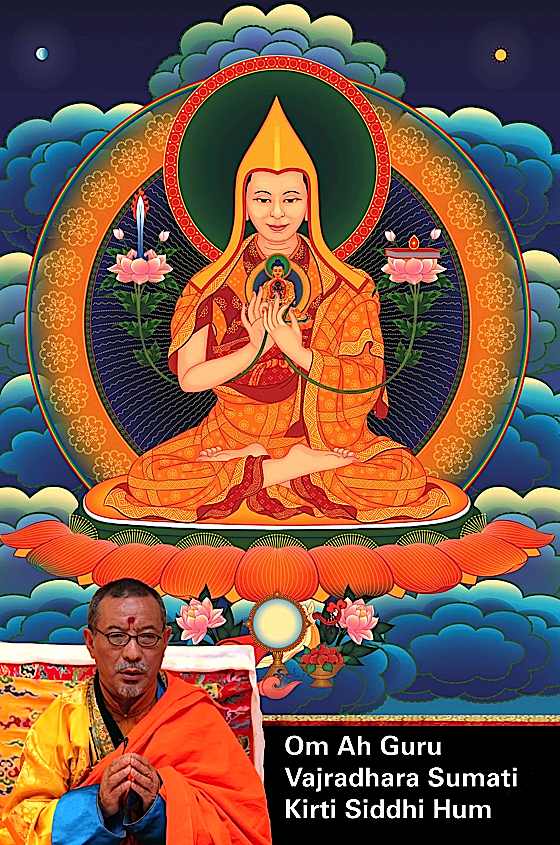
Kyabje Lama Zopa Rinpoche advised, “If one keeps even a drop of the nectar of the name of this holy being Lama Tsongkhapa in a devotional heart, it plants the seed of liberation and one receives the fortune to practice and enjoy happiness from this life up to enlightenment.”
Lama Tsongkhapa is the second historical Buddha of our times in Vajrayana tradition. As an enlightened being, Buddha Tsongkhapa has the same realizations as all of the Conquerors (Buddhas). His practice is very powerful, in part, because he was an emanation of Avalokitesvara (compassion), Manjusri (wisdom), and Vajrapani (power).
He is visualized as a kind guru, smiling and beautiful, with a tall yellow pandit’s hat, seated on a lotus throne, with all the marks and signs of a Buddha. His kind, smiling visage makes him approachable to many new to His practice, while his authority as a great Sage makes him reliable and beneficial.
Tsongkhapa, the Second Great Sage
Tsongkhapa (rJe Tsong-kha-pa Blo-bzang grags-pa) (1357-1419) is considered, by millions of believers, to be the second great sage. Shakyamuni, the historical Buddha, is the great Sage of our times, the Enlightened Buddha. Sutras recount the teachings of the Sage of the Sakyas, born as Prince Siddartha. Tsongkhapa, the second sage, wrote his teachings in numerous authoritative texts. His teachings rejuvenated Buddhism at a time when it fell into degenerate beliefs, and fused Sutra practices with Tantra. Tsongkhapa’s teachings instilled such belief and practice in Tibetan Buddhists that it changed the history of Asia. Practices Tsongkhapa taught found their way into China, Japan, Korea, India and ultimately around the world.
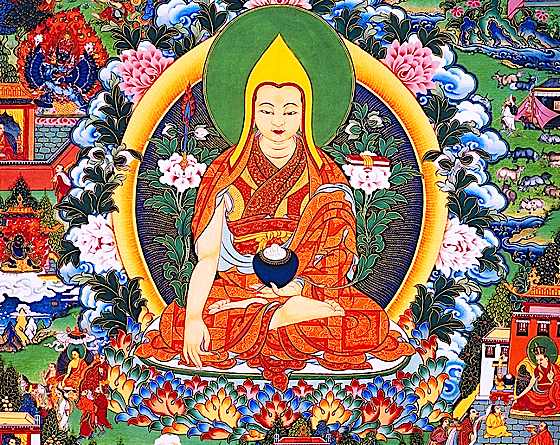
“Both Buddha Shakyamuni and Guru Rinpoche prophesied Tsongkhapa’s birth and attainments,” wrote Alexander Berzin, August 2003, partly based on a discourse by Geshe Ngawang Dhargyey, Dharamsala, India. “Buddha prophesied Manjushri would be born as a boy in Tibet, would found Ganden monastery, and would present a crown to [Buddha’s] statue… Guru Rinpoche also prophesied a monk named Lozang-dragpa would be born near China, would be regarded as an emanation of a great bodhisattva…”
In the Manjushri Root Text Buddha says, “After I have passed away, you will in the form of a child perform the actions of buddha.”
Tsongkhapa Practice: Short, Complete and Powerful
Daily Lama Tsongkhapa’s Guru Yoga makes it easier for us to develope compassion, and let go of anger. It is a short practice, ideal for busy people with little time to meditate.
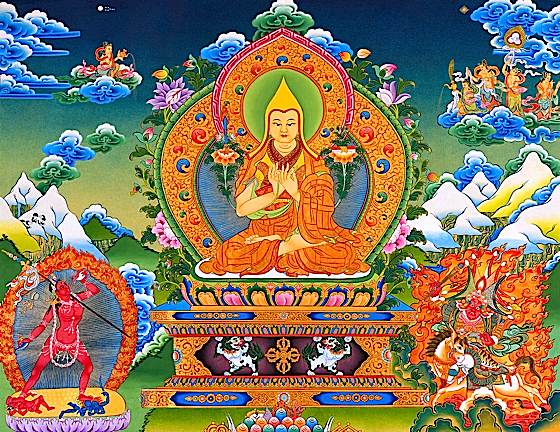
The students of teacher Venerable Zasep Tulku Rinpoche, are taught in the “Guidelines for Students” to study sutra, tantra, Mamhamudra, Lam Rim Chen Mo, and deity yoga: “This is the order… Lama Tsongkhapa including Manjushri, Chenrezig, Vajrapani” followed by other Kirya Tantra deity practices. (Audio teachings from the 13th Zasep Tulku are available here>>)
Tsongkhapa Mantra and Migstema
The mantra of Lama Tsongkhapa, which can be spoken by anyone, is:
OM AH GURU VAJRADHARA SUMATI KIRTI SIDDHI HUM
The Migstema Tsongkhapa mantra chanted by Chanted by Lama Ngawang Thogmey. Recorded in san Antonio, Texas.
The Migstema mantra can also be spoken and visualized by anyone for great benefits:
MIG MEY TZE WAY TER CHEN CHENREZIG
DRI MEY KHYEN PI WANG PO JAMPAL YANG
DU PUNG MA LU JOM DZEY SANG WEY DAG
GANG CHENG KE PEY TSUG GYEN TSONGKHAPA
LO SANG TRAG PEY SHAB LA SOL WA DEB
This can also be spoken in English, although it tends to be easier to memorize, chant and empower in the Tibetan. The English reads as:
Objectless compassion, Cherezig
Lord of stainless wisdom, Manjushri,
Conquering mara’s hordes, Vajrapani,
Crown jewel of the Sages of the Land of Snows, Tsongkhapa,
Losang Drakpa, at your feet, I pray.
Some teachers say that the Migstema mantra is so very powerful because it combines the great mantras of Avalokitesvara (Chenrezig), Manjushri and Vajrapani:
Objectless compassion, Cherezig OM MANI PADME HUM
Lord of stainless wisdom, Manjushri OM AH RA BA TSA NA DHI
Conquering mara’s hordes, Vajrapani OM VAJRAPANI HUM
Crown jewel of the Sages of the Land of Snows, Tsongkhapa,
Losang Drakpa, at your feet, I pray.
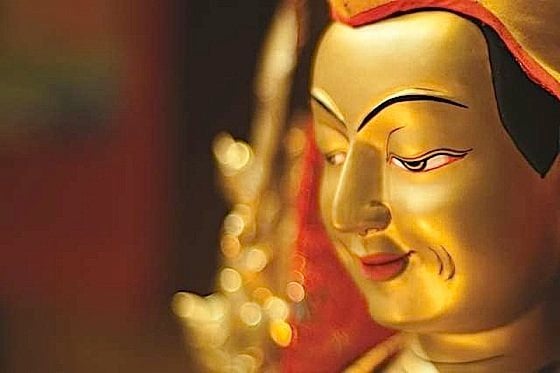
A Simple Practice Containing All 84,000 Teachings of Lord Buddha
The short Guru Yoga of Lama Tsongkhapa, on one level, contains all the 84,000 teachings of Lord Buddha. As the practice is short, it is easy to memorize, and quick to practice — ten minutes from beginning to end if you don’t pause to meditate or to chant extra mantras.
Tsongkhapa’s writings, particularly his The Great Treatise On The Stages Of The Path To Enlightenment, helped re-invigorate the practices of Vajrayana Buddhism, and has been read and studied by millions. Now, translated into English, in three volumes, The Great Treatise On The Stages Of The Path To Enlightenment is accessible to English-speaking peoples for the first time.
“Of the many works of the Tibetan master Tsongkhapa, none compare in terms of popularity and breadth of influence with his Great Treatise on the Stages of the Path to Enlightenment (Lamrim Chenmo), which has been treasured by practitioners and scholars alike for centuries,” wrote His Holiness the IVth Dalai Lama
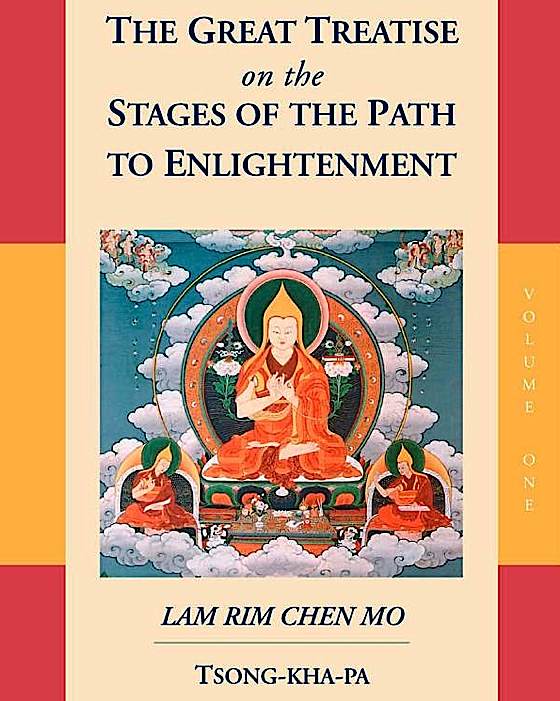
“What distinguishes it as one of the principal texts of Mahayana Buddhism is its scope and clarity. It expounds the entire path from the way one should rely on a spiritual teacher, which is the very root, right up to the attainment of Buddhahood, which is the final fruit. The various stages of the path are presented so clearly and systematically that they can be easily understood and are inspiring to put into practice.”
In Praise Of The Incomparable Tsongkhapa
By Gyalwa Mikyo Dorje, the Eighth Karmapa (1507 – 1554)
Once when Gyalwa Mikyo Dorje was travelling through the Charida Pass, thoughts of the incomparable Tsongkhapa welled up within him. Overcome by profound faith, he was moved to compose the above poem.
At a time when nearly all in this Northern Land
Were living in utter contradiction to Dharma,
Without illusion, O Tsongkhapa, you polished the teachings.
Hence I sing this praise to you of Ganden Mountain.
When the teachings of the Sakya, Kargu, Kadam
And Nyingma sects in Tibet were declining,
You, O Tsongkhapa, revived Buddha’s Doctrine,
Hence I sing this praise to you of Ganden Mountain.
Manjushri, the Bodhisattva of Wisdom, gave to you
Special instructions on the thought of Nagarjuna.
O Tsongkhapa, upholder of the Middle Way,
I sing this praise to you of Ganden Mountain.
“Mind and form are not empty of their own natures
But are empty of truly existent mind and form”,
You, O Tsongkhapa, are Tibet’s chief exponent of voidness,
Hence I sing this praise to you of Ganden Mountain.
In merely a few years you filled
The land from China to India
With peerless holders of the saffron robes.
Hence I sing this praise to you of Ganden Mountain.
Those who become your followers
And look to you and your teachings
Are never again disappointed or forsaken.
Hence I sing this praise to you of Ganden Mountain.
The trainees who walk in your footsteps
Breath the fresh air of the Great Way.
They would die for the good of the world.
Hence I sing this praise to you of Ganden Mountain.
Anyone who disparages your doctrine must face
The terrible wrath of the Dharma protectors.
O Tsongkhapa, who abides in truth’s power,
I sing this praise to you of Ganden Mountain.
In person and in dreams you come to those
Who but once recollect your image.
O Tsongkhapa, who watches with compassionate eyes.
I sing this praise to you of Ganden Mountain.
In order to civilize men and spirits you spread
Your teachings through Kham, Mongolia and Turkestan:
O Tsongkhapa, subduer of savages,
I sing this praise to you of Ganden Mountain.
For men coarse and far from the Way, you dispel
Mental clouds, evils and bad karma.
O Tsongkhapa, who bestows quick progress,
I sing this praise to you of Ganden Mountain.
Those who take heartfelt Refuge in you,
Even those with no hope for now or hereafter,
O Tsongkhapa, have their every wish fulfilled.
Hence I sing this praise to you of Ganden Mountain.
Having exposed false teachings transgressing
The excellent ways well shown by Buddha,
You firmly established your Bold Doctrine.
Hence I sing this praise to you of Ganden Mountain.
Manifesting sublime austerity and discipline,
The form and fragrance of your life was incomparable.
O Tsongkhapa, controlled one pleasing to the Buddhas,
I sing this praise to you of Ganden Mountain.
By the strength of the sons of your lineage
And by my having faithfully offered this praise,
May the enlightened activity of Buddha Shakyamuni
Pervade the earth for ages to come.

Lama Zopa Rinpoche’s Dedication:
From the merits collected by doing this work, transmitting Lama Tsongkhapa’s pure teaching — the heart of the 84,000 teachings of Buddha — into a western language, in a way as close as possible to the words and the meaning of the root text;May this be most beneficial for all sentient beings, bringing kind mother sentient beings — whose lives are lost, under the control of karma and delusion, totally enveloped in the darkness of ignorance — to the achievement of enlightenment as quickly as possible.
May anyone who merely sees this text, reads this text, teaches this text, hears about this text, or keeps this text thereby actualize indestructible guru devotion, seeing the Guru as Buddha, and train well in the three common principles of the path, actualize the two stages, and achieve the unified state of Vajradhara as soon as possible. May he or she especially generate loving kindness, the compassionate thought, and bodhicitta and immediately become a source of peace and happiness for all sentient beings, especially in this world, and may all war, famine, disease, sickness, epidemics, torture, poverty, and the dangers of fire, water, wind, and earthquakes immediately cease so that no one will experience any of these undesirable circumstances ever again.
May the pure teachings of Lama Tsongkhapa flourish continuously and spread in all directions.
The post Lama Tsongkhapa Practice: Harmony, Permanent Happiness and Complete Healing appeared first on Buddha Weekly: Buddhist Practices, Mindfulness, Meditation and News.


















